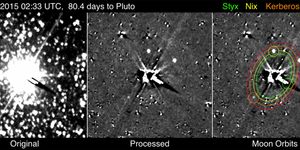NASA's Curiosity Rover has been exploring the lands of Mars for over two-and-a-half years. Also known as the ‘Red Planet,' Mars is the fourth planet from the sun in our solar system right behind our very own planet Earth.
During a normal sunny day here on Earth, we typically see a beautiful blue sky when the skies are clear. If you were to step outside on Mars at the same time of the day in the same conditions, you would see an orange sky that much resembles the ‘red' color of the planet from outer space.

Interestingly, when the Sun begins to set in the evening, both Earth and Mars appear to trade shoes. When the Sun begins to set on Earth, we develop Mars-like sky qualities that are orange in color, and as it would appear from recent images taken by NASA, when the Sun begins to set on Mars, the Red Planet starts to develop Earth-like sky qualities that are blue in color.
The images sent over by NASA's Curiosity Rover after a day of watching the skies on April 15th, 2015 show the beautiful blue hue given off by a Martian sunset:
Not only does the Sun itself give off a blue light in the picture, the entire surrounding atmosphere around the Sun also gives off blue hues when struck by the Sun's light.
So what causes this to happen? - As NASA's Mark Lemmon explains, the composition of the atmosphere on Mars is different from that of the atmosphere here on Earth in that Mars has dust in the atmosphere that reacts with the incoming sunlight to produce a blue effect on the sky.
"The colors come from the fact that the very fine dust is the right size so that blue light penetrates the atmosphere slightly more efficiently. When the blue light scatters off the dust, it stays closer to the direction of the sun than light of other colors does. The rest of the sky is yellow to orange, as yellow and red light scatter all over the sky instead of being absorbed or staying close to the sun."
NASA does note that the images were taken in between some heavy dust storms, which helped increase the amount of dust in the skies at the particular time of the sky-watching event and amplified the effects of the blue sunset. Nonetheless, it's a surprising outcome for a planet that has been labeled the "Red Planet."
Written by Anthony Bouchard









